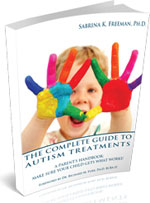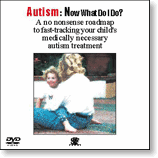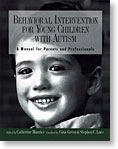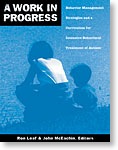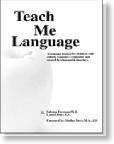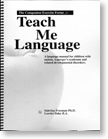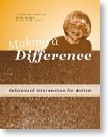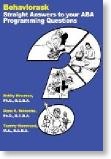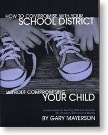If you’d like to have your opinion included, please contact me.
Here's a little thought about "testimonials".... I often tell people that, "I truly believe God could have healed my son" but I still needed to provide science-based treatment for him to reach best-outcome. If I only told people to "pray" and their child could also reach best outcome I wouldn't be helping but rather hindering. So many people have asked me if I thought that it was God or the treatment that helped my son. I tell them it was both; but I can only prove the one. Provide treatment; and pray too!
On another topic, I look so forward to reading your posts and I never skip any!
I am going to call you the "Michael Moore" of autism!!
My son got his learner's license on his birthday and doing brilliantly in Physics and calculus (grade 11).
Your blog is great!!
Pundit describes you perfectly; a genius and guru in this field.
L. Guerra
Surrey, Canada
Here are what others think about my books, & DVD:

The Complete Guide to Autism Treatments
By
JSMom
This review is from: The Complete Guide to Autism Treatments. A Parent's Handbook: Make Sure Your Child Gets What Works! (Kindle Edition)
This is the one book parents of a child with autism need to read FIRST! It gives you the no nonsense facts about treatments and the science behind them. Parents need the knowledge contained in this book so THEY can be armed with the facts and then can make the decisions for treatments for their child. This isn't a book about doing something that makes the author more money or done to increase her ego....this book is written/researched out of the passion of a mother with a child with autism - who only wants to arm parents with the understanding of science that NEEDS to be behind treatments for our kids and to give YOU the parent the power to decide which treatment that should be - not the Dr. -not the School - not your next door neighbour who heard about it on the news - YOU. Buy this book for yourself - or anyone you know who has a child with autism. You will not be disappointed - it may just change their future.
This book should also be required reading for all special ed teachers/for all child psychologists and those who work in the field of autism. If these professionals would understand the NEED for science based treatment for this population - what changes we would see.
Buy this book - give yourself the power to make an informed decision - you deserve that - your child deserves nothing less than that.
By
Martin Ivancic - See all my reviews
This review is from: The Complete Guide to Autism Treatments, A Parent's Handbook: Make Sure Your Child Gets What Works! (Paperback)
Check out this quite favorable review..
Foxx, R.M. (2010). "On Books, The Complete Guide to Autism Treatments: A Parent's
Handbook: Make Sure your Child Gets What Works! The Behavior Analyst, 33, 133-138.
By
Jennifer Luchesi Long
Schoolsurvivalist,
Parent Support for Getting Kids Through School, Happily
A wonderful book came my way after my article about teaching compassion for children with Autism was published. This book, The Complete Guide to Autism Treatments A Parent’s Handbook: Make Sure Your Child Get What Works!, by Sabrina K. Freeman, Ph.D. provides an incredibly detailed and research-based assessment of over 30 treatments for Autism. Dr. Freeman discusses each treatment in detail, providing evidence from practitioners as to each treatment’s benefit, and then candidly expresses whether or not she would pursue such treatment for her own child based on scientific criteria. This book focuses on science first and weeds out treatments that are not proven to work. Extensive bibliographies throughout, Dr. Freeman has provided an easy to access wealth of knowledge sure to bring peace of mind to parents struggling with what steps to take in treating their child with Autism.
By
David Celiberti, Ph.D., BCBA
President, Association for Science in Autism Treatment
Dr. Freeman is a prolific writer who has published numerous works related to autism and its treatment. Her latest book, The Complete Guide to Autism Treatments, may indeed be her most important contribution to parents of children with autism, as well as to those professionals who work with this clinical population. The book is comprehensive, thoroughly researched, and well organized. Throughout the book, Dr. Freeman communicates a critically important message: Individuals with autism deserve access to science-based treatment; their time, their potential, and the overall resources of their families should never be wasted. Th The Board of the Association for Science in Autism Treatment (www.asatonline.org) could not agree more.
The book is divided into two primary sections. Section I is organized around topics related to the various treatments for autism, of which there are several dozen. Section II highlights basic concepts about science, hypothesis testing, and research methodology. Section I begins with a review of behavior-analytic treatments for autism across home and school settings, as well as within the area of early intervention. The various offshoots of applied behavior analysis are also summarized and evaluated. Then there is a fairly comprehensive section related to the myriad non-behavioral treatments, including those that occur in school, as well as those that are child-initiated or parent-facilitated. These subsections are followed by biomedical therapies, speech and language therapies, and, ultimately, a final section for miscellaneous therapies not better categorized in the above subsections. Each of these subsections is divided, and in some cases divided further, in an effort to capture the more frequently-touted treatments for autism.
It is frankly unfortunate that such an extensive taxonomy is needed simply to categorize all that which is available to consumers, particularly given that the vast majority of treatments proposed for autism lack adequate scientific support. Consumer advocates who think that exposure to many diverse treatment options is a good thing are likely not considering the agonizing decisions parents must make about how best to help their child with autism, the second guessing and guilt that may come from worrying that one is not doing enough, and the extraordinary financial burdens that come from paying for numerous treatments out of pocket.
Parents of children with autism - particularly those with newly diagnosed children - face a dizzying array of options that can be absolutely overwhelming. Do parents of children from any other clinical population have to face these matters to the extent that we see in autism? Quite simply, no. Parents of children with autism deserve all of the information needed to consider possible treatments carefully and to make the most informed decision for their child. Fortunately, this book will be of tremendous help in that regard, for Dr. Freeman’s review and description of the available research is presented in a careful, thorough and straightforward manner. Each of these treatment subsections is organized around responses to a series of 9 questions.
This book has many notable strengths. The format of 9 recurring questions within Section I provides a predictable framework for the reader. In fact, Dr. Freeman’s careful analysis of the state of the research underlying specific ABA treatments is offered in the same spirit and with the same diligence as the non-behavior analytic treatments. This is critically important, given that the abundance of research in ABA may mistakenly give the impression that all that falls under the umbrella of ABA is well supported empirically. This could not be further from the truth. Although some behavior analysts who are proponents of Positive Behavior Support, Verbal Behavior Therapy, Fluency Training, and Pivotal Response Training may disagree with many of Dr. Freeman’s specific assertions, the quality of her analyses and the clarity of her concerns contribute to a much less divisive dialogue then we have seen in other books to date.
Proponents of the various treatments would benefit from careful consideration of the suggestions offered in the “research needed” section. Far too often, a single study is put forth as validation of an entire treatment and all of its theoretical and conceptual underpinnings. For instance, as Dr. Freeman discusses in her book, a published research study that uses an art activity to integrate children with autism with their typically developing peers in no way validates art therapy as a treatment for autism. A well designed study in which a clearly developed treatment protocol for art therapy is implemented and dependent variables are selected that measure core manifestations of autism is the type of research that is desperately needed. The reader will find that Dr. Freeman has individualized her recommendations based on each treatment’s existing research history. Execution of these research agendas may enable a number of treatments to live up to their promise.
Perhaps of greatest significance is that that the author is writing from the dual perspectives of professional and parent. When speaking as a parent, her commitment to science is unwavering and, appropriately so, she is unapologetic in honestly sharing her perspectives as an informed mother. This is sorely needed at a time when many individuals fear being perceived as close-minded or unwilling to recognize the contributions of other disciplines. Her professional perspective only adds further credence to her stance regarding treatment options.
There are wonderful insights throughout the book which will make this resource useful to those who will tend to read this book a few sections at a time. For instance, there is a very interesting discussion at the beginning of the book about participation in research with the caveat that precious time and resources should never be wasted on low-quality research, for not all research is created equally.
There are a few minor concerns. Many readers may have benefitted from an introduction to some of the content in Section II at the very beginning of the book. To her credit, Dr. Freeman makes the suggestion to review this content first. I suspect this introduction would have laid a foundation for readers to synthesize the tremendous amount of information in Section I. Organizationally, I believe that the judicious use of tables and charts would have facilitated comparisons across treatments. Clearly, many parents are surrounded by those who support their informed decision making and their commitment to science-based treatment. Unfortunately, there are many parents who find their efforts punished or derailed by those with competing agendas. Therefore, this comprehensive resource would have been further strengthened by specific and concrete strategies for both managing the behavior of others involved in treatment decisions, and for resisting and responding to pressures exerted by others to “just try” a particular treatment (e.g., the mother-in-law who argues that the gluten free diet is harmless, so why would one not want to try it).
In summary, I believe this book is a much needed contribution to the field of autism. The diligence and comprehensiveness of the various treatment reviews make this book an important “go-to” resource for parents and professionals alike. Undoubtedly this is a resource that the reader can expect to pick up time and time again.

Teach Me Language: A Language Manual for children with autism, Asperger’s syndrome and related developmental disorders
By
Vivien - See all my reviews
This review is from: Teach Me Language: A Language Manual for children with autism, Asperger's syndrome and related developmental disorders. (Hardcover-spiral)
This book is an invaluable tool for teaching language,to people with asperger syndrome. It combines pattern recognition with exercises and repetition. It layers the learning, gradually building up the knowledge and understanding. I think it's a really clever way to teach language to aspies. If only my child had been taught using this book. EVERY SCHOOL SHOUD HAVE ONE!!
By
pmagroup - See all my reviews
This review is from: Teach Me Language: A Language Manual for children with autism, Asperger's syndrome and related developmental disorders. (Hardcover-spiral)
This is an OUTSTANDING RESOURCE for helping anyone with language deficits. Delivery was immediate. I could not be more thrilled to have this 'how to' book, showing me the way to help my two ASD grandsons. (Put it together with A WORK IN PROGRESS and you are set to make a real difference in your autistic child's life!)
1 of 1 people found the following review helpful:
By
olivia717 (San Diego, CA) - See all my reviews
This review is from: Teach Me Language: A Language Manual for children with autism, Asperger's syndrome and related developmental disorders. (Hardcover-spiral)
As an educator for children with autism, I read A LOT of books because my job is to learn skills and strategies in order to train people. One of the most requested things that teachers need help with is how to teach social skills to their students on the spectrum. This is by far the best social skills training manual that I have gotten my hands on. It gives examples of what to say to the child and why that skill is important. A lot of times, social skills books will contain great programs that you can implement, but not everyone is proficient enough to actually get them started because the instructions are not very clear. All I have to say is, you need to get this book for yourself if you work with children with special needs!
63 of 64 people found the following review helpful:
By
Cindy (Minnesota) - See all my reviews
This review is from: Teach Me Language: A Language Manual for children with autism, Asperger's syndrome and related developmental disorders. (Hardcover-spiral)
A Real Winner! This book is an excellent resource for parents and therapists who teach language to children with autism, Asperger's syndrome, and other related developmental disorders. Instructional friendly explanations, games, and cards teach language skills used in school and in life. The key feature that I really like about this book is that all information is very visual and structured. This book targets the areas of social language, general and functional knowledge, grammar and syntax, written expression, and academic concepts such as sequencing, problem-solving, time and money. Once a child has some basic vocabulary and can answer simple "what" and "where" questions, this book should be in your hands! Activities in this book are practical with children from kindergarten through the teenage years.
37 of 38 people found the following review helpful:
By
Frances (FL) - See all my reviews
This review is from: Teach Me Language: A Language Manual for children with autism, Asperger's syndrome and related developmental disorders. (Hardcover-spiral)
Teach Me Language really zeros in on the areas of difficulty which our children with Autism and related disorders are up against. As a mother and educational advocate of a son with "high-functioning autism," I was thrilled to find this user-friendly educational tool that helps our kids "fill in the blanks." It provides a wonderful curriculum that can be used in collaboration by teacher/speech pathologist and parent, thereby offering our kids a very solid program. I've found the suggested instruction/therapy schedules (similar to lesson plans) particulary helpful.
12 of 12 people found the following review helpful:
By
Angie, Mom of 3 (British Columbia, Canada) - See all my reviews
This review is from: Teach Me Language: A Language Manual for children with autism, Asperger's syndrome and related developmental disorders. (Hardcover-spiral)
When I discovered how expensive speech/language therapy cost for my 9-year-old son with autism, I began looking for resources and ways that I could improve his language in our home. I came across this book and it has been invaluable.
'Teach Me Language' is for children who have done some preliminary language work and have a fairly good foundation in labeling objects as well as pre-reading skills. The exercises are based on written words instead of pictures, so you will want to make sure your child is ready for that step.
The Manual features exercises on a variety of topics - everything from reading and comprehension skills to grammar basics to lifeskills like telling time and dealing with money to understanding emotions. In other words, the book features every area with which my son struggles. There is also an excellent chapter on social language and how to teach reciprocal conversations.
I found the layout of the manual to be just a bit confusing because it is not linear but that actually makes sense because the way our children learn isn't linear! Some children with autism or Asperger’s may be particularly strong in certain areas and weak in others.
Chapter 7 in the manual explains how to set up a language schedule for your particular child and you then go through the exercises and decide which ones to teach.
For parents, this book is easy to read, understand and implement. I highly recommend it, especially for children with autism who have emerging language and reading (decoding) skills.
8 of 9 people found the following review helpful:
By
Bobby Newman (Long Beach, NY USA) - See all my reviews
This review is from: Teach Me Language: A Language Manual for children with autism, Asperger's syndrome and related developmental disorders. (Hardcover-spiral)
This manual provides a tremendously useful resource for anyone involved in teaching conversational skills to individuals with language-based disabilities. There are pre-requisite skills a student must have, so this is probably not going to be the first book you start with if the student has few verbal skills. It is, however, the book that you will build up to and use extensively during that "middle" ground on the way to completely fluent conversational and language skills.

Science for Sale in the Autism Wars
4 of 6 people found the following review helpful:
By A Customer
This review is from: Science for Sale in the Autism Wars: Medically necessary autism treatment, the court battle for health insurance and why health technology academics are enemy number one (Paperback)
Every parent of every child with autism should read this book. It will open your eyes to the way governments use taxpayer dollars to cheat children out of the medical treatment they so vitally need...and it will prepare you for the fight for your own children's rights. Do NOT miss this book!
3 of 5 people found the following review helpful:
By
Bobby Newman (Long Beach, NY USA) - See all my reviews
(VINE VOICE) (REAL NAME)
This review is from: Science for Sale in the Autism Wars: Medically necessary autism treatment, the court battle for health insurance and why health technology academics are enemy number one (Paperback)
Another essential read from Sabrina Freeman. Any parent or advocate fighting for the necessary treatment for people with autistic-spectrum disorders must get a copy of this book. It is frightening to see how easily the science can be misquoted and misused in the effort by some to avoiding paying for scientifically-validated treatment. When you have to prepare yourself for the fight, this a resource you must have.
2 of 4 people found the following review helpful:
By
Kenneth F. Reeve (Caldwell College, NJ United States) - See all my reviews
This review is from: Science for Sale in the Autism Wars: Medically necessary autism treatment, the court battle for health insurance and why health technology academics are enemy number one (Paperback)
Parents of children who are affected by autism spectrum disorders are well aware of the need to serve as effective advocates for the rights of their children. Imagine the battle that needs to be waged when an entire government fights to withhold funding for the only empirically validated intervention for autism, applied behavior analysis (ABA). Freeman describes the events that occur when a lawsuit is brought about by a group of parents against the government of British Columbia. The lawsuit argues for funding for "Lovaas-style" ABA therapy. In an attempt to block the funding of ABA therapy, the government of British Columbia attempts to discredit Lovaas and ABA through a combination of distortions, selective reporting of the research literature, and questionable ethical practices.
In part one, Freeman outlines the specific strategies used against the parents' lawsuit while explaining why the government of B.C. is outright incorrect in its assertions against ABA and Lovaas. In the second part of the book, Freeman provides dialogue between the lawyers and witnesses (from actual court records) that depict these arguments and counter-arguments. Happily, the British Columbia Supreme Court ruled in favor of the parents by declaring that early intensive behavioral intervention (EIBI) is a "medically necessary" treatment for autism and that the B.C. government was in violation of the constitutional rights of the children by not providing funding for this treatment. The court also ruled that the case against Lovaas therapy was biased. Unfortunately, the book concludes by pointing out that the government of B.C. appealed the court's ruling and has still not implemented the funding of Lovaas-style ABA.
This book is a must read for anyone involved in the lives of someone affected by an autism spectrum disorder. It should also be on the reading list of all legal advocates who work in the field of developmental disabilities. Freeman gives us a wonderful guide for effectively arguing against those who would refute the validity of ABA as a science and as an empirically validated educational intervention. "Science For Sale" is a wonderful "candle in the dark" in the field of autism treatment.

Autism: Now What Do I Do?
6 of 6 people found the following review helpful:
By
"cjirik3" (Calgary, Alberta) - See all my reviews
This review is from: Autism: Now What Do I Do? [DVD]
After watching this video, I would consider it essential viewing not only for parents of newly diagnosed children with autism, but also for parents who have lost their way in the minefield of unproven therapies and quack cures that abound for this devastating condition.
5 of 5 people found the following review helpful:
By
Barbara Rodrigues (Canada) - See all my reviews
This review is from: Autism: Now What Do I Do? [DVD]
This is a great video with tons of information. It gives a new parent practical advice along with much hope. It starts out with the basics of how to get a diagnosis - what do next - how to find a consultant and therapists. It gives lots of suggestions for what to look for in a good ABA program - books and videos to watch. I wish this was available five years ago when we got our diagnosis. It is a wonderful tape for all parents of children with autism to have in their library. Well worth the price.
